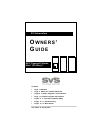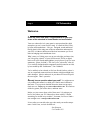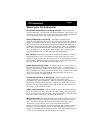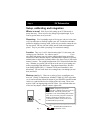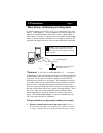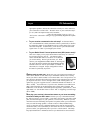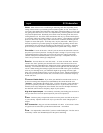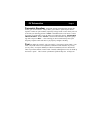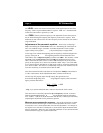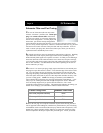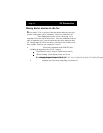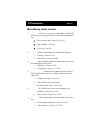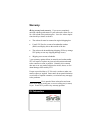
SV Subwoofers
Page 6
appropriate speakers, and use the subwoofer correctly too. Also, make sure
your subwoofer is turned “ON”. We don’t mean “is your subwoofer
ampli-
fier
on” (that’ll be important later too!) but rather,
is your receiv er se n d ing a
bass signal to your sub amp
? This can only happen if you say “Yes” (or
“ON”) to the “subwoofer” setting of any typical Dolby Digital/DTS capable
receiver.
•
I
s your receiver connected to the sub amp?
As discussed above,
use a well-shielded RCA cable (sometimes called a “patch cord”) to hook to
the subwoofer output of your DD/DTS receiver to either input jack of your
subwoofer amplifier. As mentioned, you’ll need to “split” the subwoofer
signal with a “Y Cable” if you bought a pair of subs.
•
I
s your Radio Shack ® sound pressure level (SPL) meter ready?
This tool is simply
vital
to proper home theater audio setup. It’s akin to a
tire pressure gauge for your car. The manual which
comes with the SPL meter is excellent; we recommend
you read it entirely. Haven’t got the meter yet? Head
down to your neighborhood Radio Shack ® and snag one.
We prefer the analog instead of the digital display model
but both work well. Ask for part number
#33-4050
. At
about $40, it’s a bargain. Proper configuration
without
this meter is practically
impossible
.
Getting ready to start now: Make sure your receiver/processor master vol-
ume is set at “00 dB” or some other easy to remember reference level. Finally,
ensure your SVS’s volume control is set no more than 1/4 to 1/3rd up at first. It’s
also critical to check the subwoofer level control of your surround receiver before
you begin the test tones. Set it to no higher than “-5 dB” initially (that’s one
quarter way up, given a typical receiver’s subwoofer channel level limits of –10
dB to +10 dB) . Your LFE “trim”, if you have one, should be set to 0dB to start
(that’s full up) but this can be dialed down later to tame peaks if needed. IM-
PORTANT: Turn off ANY sound-field processing modes, “peak limiters”, “mid-
night mode” etc.
Set the SPL meter to “Slow” and “C-weighting” (turn the range
dial to 70dB).
Now play your receiver's internal test tones so you have something
to measure with your SPL meter. Or better yet, buy a calibration disk like
the Video Essentials, or Avia DVDs. A test disk’s tones ensure your entire signal
path, from the DVD player to your speakers, is set correctly. Whatever you use,
when the tones start alternating from speaker to speaker (watch your sound meter
now), set each full range speaker’s volume to about 75 dB (or 85dB if using
Avia), by using the receiver’s dedicated channel level controls (leaving master
volume the same). We recommend you turn down the receiver’s subwoofer out-
put level, before you significantly lower your sub’s volume control. This helps
keep input distortion to a minimum, however you should not be set much lower



